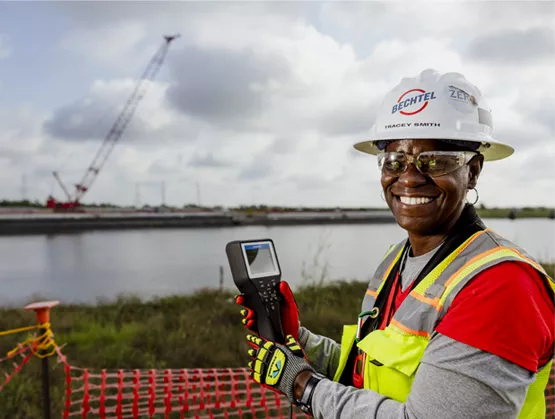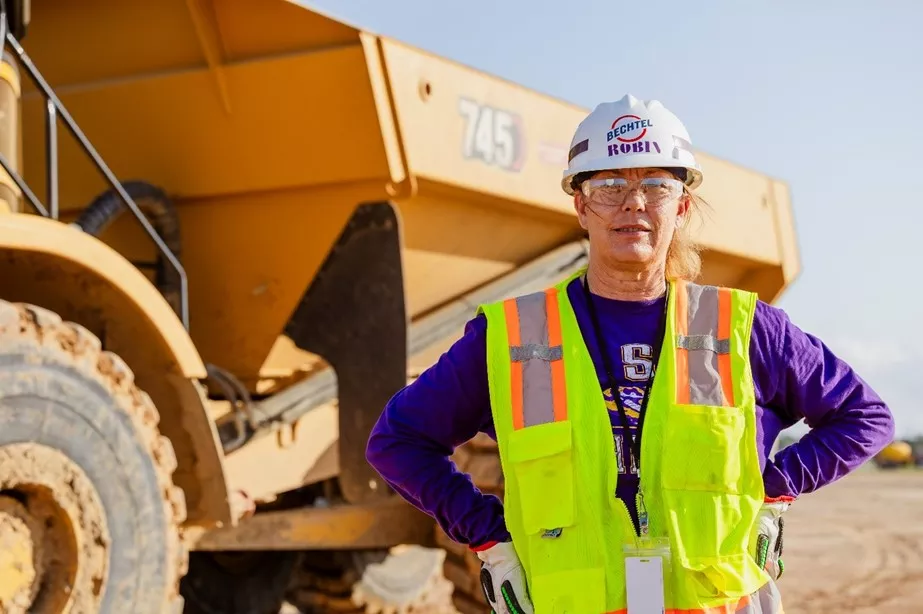
Encouraging more women to pursue careers in construction trades is a business imperative for the semiconductor industry as it looks to build new fabs.
Semiconductor makers have plans to build a wave of new manufacturing plants and other capital projects to increase production in the U.S. – just as Congress and the administration envisioned when they passed the infrastructure bill and the CHIPS and Science Act.
The question now is does America have enough construction workers to fill the many hundreds of thousands of new construction jobs the U.S. Department of Commerce estimates these new laws will create. At the moment, the answer is no.
Building a modern semiconductor fab takes armies of skilled craft professionals, from pipefitters and welders to electricians, carpenters, HVAC installers and so on.
When selecting a site for new capital projects, fab owners consider the local workforce for operations. They also need a delivery partner that can attract and retain the large workforce of skilled craft professionals needed for success.
Construction of Intel’s new facility in Ohio, for example, will require hiring more than 7,000 skilled craft positions – more than twice the number of workers who will staff the plant once it is in operation.
 These needs for skilled craft professionals are growing as America makes historic investments in infrastructure and advanced manufacturing. As a point of reference, the U.S. Bureau of Labor Statistics projects there will be an average of 73,500 openings for electricians, 79,500 openings for carpenters, and 42,600 openings for plumbers, pipefitters, and steamfitters every year over the next 10 years.
These needs for skilled craft professionals are growing as America makes historic investments in infrastructure and advanced manufacturing. As a point of reference, the U.S. Bureau of Labor Statistics projects there will be an average of 73,500 openings for electricians, 79,500 openings for carpenters, and 42,600 openings for plumbers, pipefitters, and steamfitters every year over the next 10 years.
As the industry looks to fill these needs, where will it find the talent? A big part of the answer will be bringing more women into the construction industry. As a result, U.S government, national building trades, and companies like Bechtel are taking steps to encourage girls and young women to pursue careers in the trades.
Diversity Key to Mobilizing a Large Construction Workforce
U.S. Commerce Secretary Gina Raimondo announced an initiative called Million Women in Construction in 2022. “There's no way the Department of Commerce is investing billions of taxpayer dollars in brand new infrastructure projects and not having those jobs go to people who look like all of America,” she said.
Bechtel works millions of craft hours globally each year. Part of our success mobilizing large workforces is increasing diversity with both our professional staff (such as engineers, construction managers, and supply chain professionals) and craft professionals.
The greatest opportunities to get more women into the construction industry are with craft professions, where the percentage of participation is much lower than professional staff. Women make up 47% of the total workforce but only 4% of the craft workforce (according to the National Center for Construction Education and Research). Adding even half a percent more women to the construction workforce would add tens of thousands of new workers.
The entry point for craft professionals is apprenticeships or technical colleges. Luckily, the number of women in these pipelines is increasing, but more work is needed to tap into the workforce that will build the next generation of semiconductor fabs.
Attracting Women to Construction Trades
I see the way to address the challenge of construction labor is to expand the pool we recruit from. That means bringing in more women to apprenticeship programs and working with our partners to fund apprenticeship programs and reach girls and young women directly.
Unfortunately, many women do not even realize construction is an option to build a rewarding career. These professions allow women earn a good income, save for the future, and support a family.
They are also jobs with a purpose. A woman working at Bechtel makes tangible contributions to growing the economy, improving the resiliency of the world's infrastructure, increasing access to energy, making the world a safer place, and securing the global semiconductor supply chain.

Bechtel equipment operator Robin Moore poses for a photo with an articulated dump in Louisiana. Women are key to overcoming the craft professional shortage.
Through partnerships with community colleges, Bechtel has established a women-only carpentry apprenticeship program and a sponsored women-only commercial driver’s license program.
The international, national, and local unions are our partners in attracting women to construction. For a large semiconductor fab built with union labor, Bechtel will typically contribute millions of dollars toward local trades apprenticeships.
The next fab built with a project labor agreement could make an important contribution to increasing the number of women in trades, especially if done in concert with a delivery partner that already looks at labor through the lens of diversity and inclusion.
Through our partnership with North America’s Building Trades Unions, or NABTU, Bechtel also supports Tradesfutures, a non-profit organization that works to support and develop women and other underrepresented groups in the construction industry.
So far, Bechtel’s efforts are working. Bechtel’s craft professional workforce includes 8% women, double the national average.
Like many challenges on major capital projects, addressing potential labor constraints is best dealt with through early planning. Early conversations with an integrated engineering, procurement, and construction partner like Bechtel can help ensure that solutions are in place so that semiconductor capital projects are not delayed by obstacles related to construction labor.
Women play a vital role in creating massive projects that shape the world. And I think Bechtel’s vision of “extraordinary teams building inspiring projects” makes it a wonderful place for women to come work.
Catherine Hunt Ryan will present at SEMI Industry Strategy Symposium January 7-10, 2024 in Half Moon Bay, California.
About the Author
 Catherine Hunt Ryan is President of Bechtel’s Manufacturing & Technology, Inc., member of the company’s Board of Directors, and executive sponsor of the Women@Bechtel employee resource group. She is responsible for worldwide design, construction and project delivery in the semiconductor, electric vehicle, and datacenter markets. Connect with Catherine on LinkedIn or email mt@bechtel.com.
Catherine Hunt Ryan is President of Bechtel’s Manufacturing & Technology, Inc., member of the company’s Board of Directors, and executive sponsor of the Women@Bechtel employee resource group. She is responsible for worldwide design, construction and project delivery in the semiconductor, electric vehicle, and datacenter markets. Connect with Catherine on LinkedIn or email mt@bechtel.com.